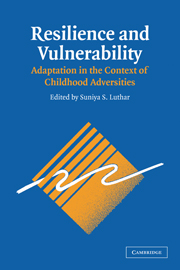Book contents
- Frontmatter
- Contents
- List of Contributors
- Foreword by Dante Cicchetti
- Preface
- 1 A Resilience Framework for Research, Policy, and Practice
- PART I FAMILIAL ADVERSITIES: PARENTAL PSYCHOPATHOLOGY AND FAMILY PROCESSES
- 2 Young Children with Mentally Ill Parents: Resilient Developmental Systems
- 3 Risk and Protective Factors for Children of Depressed Parents
- 4 Resilience and Vulnerability among Sons of Alcoholics: Relationship to Developmental Outcomes between Early Childhood and Adolescence
- 5 Maternal Drug Abuse versus Other Psychological Disturbances: Risks and Resilience among Children
- 6 Resilience to Childhood Adversity: Results of a 21-Year Study
- 7 Sequelae of Child Maltreatment: Vulnerability and Resilience
- 8 Risk and Resilience in Children Coping with Their Parents' Divorce and Remarriage
- 9 Correlational and Experimental Study of Resilience in Children of Divorce and Parentally Bereaved Children
- PART II EXOSYSTEMIC AND SOCIODEMOGRAPHIC RISKS
- PART III COMMENTARIES
- Index
- References
8 - Risk and Resilience in Children Coping with Their Parents' Divorce and Remarriage
Published online by Cambridge University Press: 05 June 2012
- Frontmatter
- Contents
- List of Contributors
- Foreword by Dante Cicchetti
- Preface
- 1 A Resilience Framework for Research, Policy, and Practice
- PART I FAMILIAL ADVERSITIES: PARENTAL PSYCHOPATHOLOGY AND FAMILY PROCESSES
- 2 Young Children with Mentally Ill Parents: Resilient Developmental Systems
- 3 Risk and Protective Factors for Children of Depressed Parents
- 4 Resilience and Vulnerability among Sons of Alcoholics: Relationship to Developmental Outcomes between Early Childhood and Adolescence
- 5 Maternal Drug Abuse versus Other Psychological Disturbances: Risks and Resilience among Children
- 6 Resilience to Childhood Adversity: Results of a 21-Year Study
- 7 Sequelae of Child Maltreatment: Vulnerability and Resilience
- 8 Risk and Resilience in Children Coping with Their Parents' Divorce and Remarriage
- 9 Correlational and Experimental Study of Resilience in Children of Divorce and Parentally Bereaved Children
- PART II EXOSYSTEMIC AND SOCIODEMOGRAPHIC RISKS
- PART III COMMENTARIES
- Index
- References
Summary
In the past 50 years in the United States, marriage has become a more optional, less permanent institution. Marriage is being delayed, rates of marital formation are decreasing, and divorce, births to single mothers, and cohabitation have increased. The divorce rate has more than doubled since 1950, and although in the past two decades it has declined modestly and stabilized, still about 45% of contemporary marriages are expected to fail (Teachman, Tedrow, & Crowder, 2000; U.S. Bureau of the Census, 1998). As the divorce rate increased in the 1970s, the remarriage rate for women began to decline. About 65% of women and 75% of men now remarry. However, divorces occur more rapidly and frequently in remarriages, especially in those involving stepchildren (Cherlin & Furstenberg, 1994; Tzeng & Mare, 1995).
The general long-term pattern of a rising divorce rate over the past 50 years and a decreasing remarriage rate starting in the 1980s holds for non-Hispanic whites, African Americans, and Hispanic whites, but the absolute levels differ for the three groups. Compared to non-Hispanic and Hispanic whites, African Americans wait longer and are less likely to marry and also are more likely to separate and divorce, to remain separated without a divorce, and less likely to remarry (Teachman et al., 2000).
As parents move in and out of intimate relationships, their children are exposed to the changes, challenges, and stresses associated with multiple family transitions.
- Type
- Chapter
- Information
- Resilience and VulnerabilityAdaptation in the Context of Childhood Adversities, pp. 182 - 212Publisher: Cambridge University PressPrint publication year: 2003
References
- 40
- Cited by



